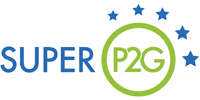Optimizing the hydrogen value chain is essential to ensure hydrogen market uptake in replacing traditional fossil fuel energy and to achieve energy system decarbonization in the next years. The design of new plants and infrastructures will be the first step. However, wrong decisions would result in temporal, economic losses and, in the worst case, failures. Because huge investments are expected, decision makers have to be assisted for its success. Because no tools are available for the optimum design and geographical location of power to gas (P2G) and power to hydrogen (P2H) plants, the geographic information system (GIS) and mathematical optimization approaches were combined into a new tool developed by CNR-ITAE and the University of Bologna in the SuperP2G project, aiming to support the interested stakeholders in the investigation and selection of the optimum size, location, and operations of P2H and P2G industrial plants while minimizing the levelized cost of hydrogen (LCOH).

In the present study, the tool has been applied to hydrogen mobility, specifically to investigate the conversion of the existing refuelling stations on Italian highways to hydrogen refuelling stations (HRSs). Middle-term (2030) and long-term (2050) scenarios were investigated. In 2030, a potential demand of between 7000 and 10,000 tons/year was estimated in Italy, increasing to between 32,600 and 72,500 tons/year in 2050. The optimum P2H plant configuration to supply the HRS was calculated in different scenarios. Despite the optimization, even if the levelized cost of hydrogen (LCOH) reduces from 7.0–7.5 €/kg in 2030 to 5.6–6.2 €/kg in 2050, the results demonstrate that the replacement of the traditional fuels, i.e., gasoline, diesel, and liquefied petroleum gases (LPGs), will be disadvantaged without incentives or any other economic supporting schemes.

